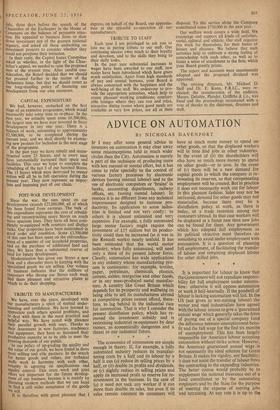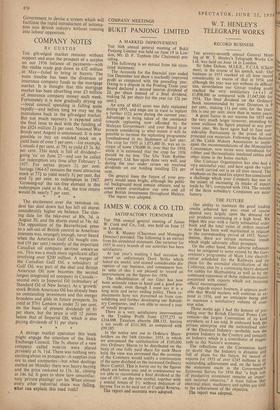ADVICE ON AUTOMATION
BY NICHOLAS
DAVENPORT
IF I may offer some general advice to investors on automation it may clear away some misconceptions held in much wider circles than the City. Automation is merely a part of the technique of producing more with less manual or mental effort, but it has come to refer specially to the control of various factory processes by electronic devices (saving manual labour) and to the use of electronic computors or 'brains' in banks, accounting departments, railway offices, etc. (saving mental labour). In essence it is no different from any technical improvement designed to increase pro- ductivity. Its application to some indus- tries is limited and not very costly: to others it is almost unlimited and very expensive. For example, a fully automated large motor factory might require . the investment of £15 million but its produc- tivity could then be increased (as it was in the Renault works) nearly tenfold. It has been estimated that the world motor industry, when fully automated, will need only a third of its present labour force. Clearly, automation has wide applications in any industry whose manufacturing pro- cess is continuous : for example, textiles, paper, petroleum, chemicals, plastics, cement, cables, margarine and other foods, or in any mass-produced metal manufac- ture. A country like Great Britain which depends for its prosperity and wellbeing on being able to sell its manufactures abroad at competitive prices cannot afford, there- fore, to lag behind in the industrial race for automation. That is why I consider the present disinflation policy, which has re- moved the investment subsidy and is restraining industrial re-equipment by dear money, as economically dangerous and a threat to our industrial future.
* * * The economics of automation are simple enough in theory. If, for example, a fully automated industry reduces its manufac- turing costs by a half and its labour by a half it can (a) reduce its selling prices by a half, or (b) double its profits and dividends, or (c) slightly reduce its selling prices and apply its increased profit to reserve for re- investment in the business. In the case of (a) it need not sack any worker if it can more than double its sales, but even if its sales remain constant its customers will have so much more money to spend on other goods, so that the displaced workers will in time find jobs in other industries. In the event of (b) the shareholders will also have so much more money to spend on other goods—or to save. In the event of (c) there will be a new demand for capital goods in which the company is re- investing its reserves, so that compensating employment will be created. But in practice it does not necessarily work out for labour in this pleasant fashion. Sales may not be increased, demand for other goods may not materialise, because there may be a disinflation policy at work, as there is today, or a trade recession among our customers abroad. In that case workers will be displaced at a faster rate than new jobs can be found for them. Any government which has adopted full employment as its political objective must therefore do something to avoid under-employment with automation. It is a question of planning full employment, of facilitating the transfer of labour and retraining displaced labour for other skilled jobs.
* *
It is important for labour to know that the Government will not repudiate responsi- bility for full employment under automa- tion : otherwise it will oppose automation or work it half-heartedly. If the goodwill of labour is lacking automation will fail. In the US (not given to wet-nursing labour) the motor and steel industrialists have agreed with the labour unions to give a 'guaranteed annual wage' which generally takes the form of paying out of a special company fund the difference between unemployment bene- fit and the full wage for the first six months of unemployment. This has been largely responsible for American labour accepting automation without strike action. However, the American guaranteed annual wage is not necessarily the ideal solution for Great Britain. It makes for rigidity, not flexibility; it does not assist the transfer of labour from the contracting to the expanding industries. The better course would probably be to supplement the national insurance out of a fund contributed to by the automating employers and by the State for the purpose of meeting the expense of moving jobs and retraining. At any rate it is up to the
Government to devise a system which will facilitate the rapid introduction of automa- tion into British industry without running into labour opposition.



































 Previous page
Previous page